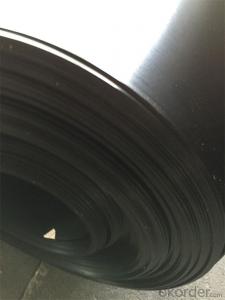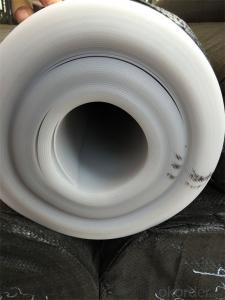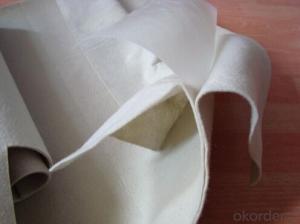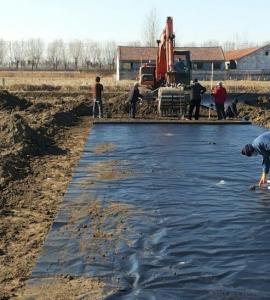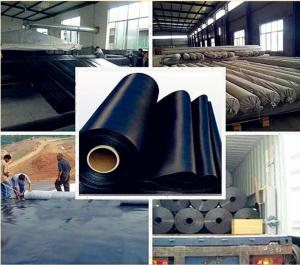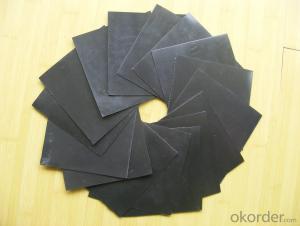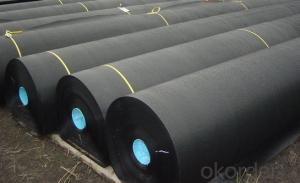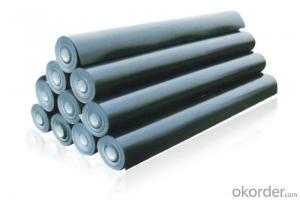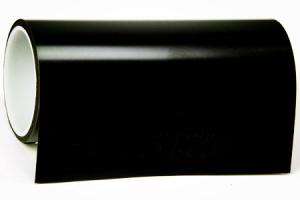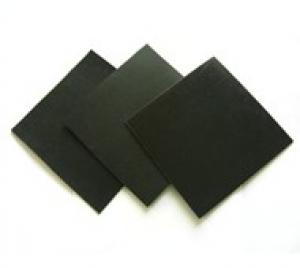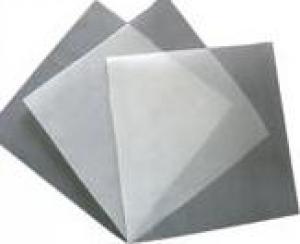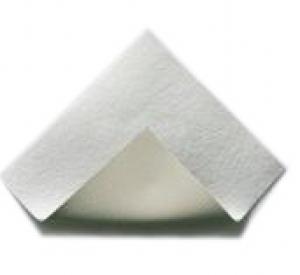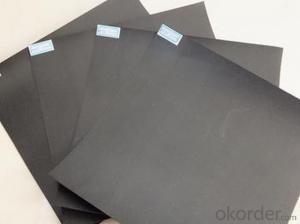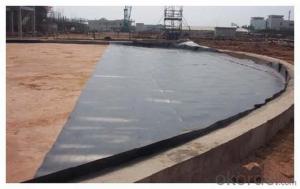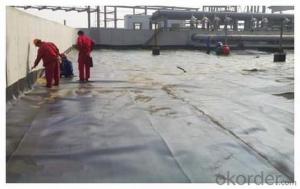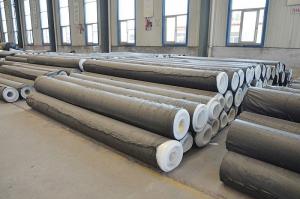Waterproof Lliner HDPE Geomembrane for Pond and Lake Dam
- Loading Port:
- Qingdao
- Payment Terms:
- TT OR LC
- Min Order Qty:
- 5000 m²
- Supply Capability:
- 2000000 m²/month
OKorder Service Pledge
OKorder Financial Service
You Might Also Like
Geomembrane Introduction:
1.Antiseepage and seperation
2.fish pond material
3.good quality and cheap price
4.fast delivery
Geomembrane Specification:
Thickness | 0.12mm-4.0mm |
Length | 50m/roll,100m/roll,150m/roll or as your choice |
Width | 5.0m-7.0m or as your choice |
Color | White/Black/Blue/Green,mainly black |
Material | HDPE |
Delivery port | Qingdao |
Package: | woven bag or as customers' requests |
Product time | 2-20 days |
Features | 1.Good physical and mechanic performance |
2.High tearing resistance, strong deformation adaptability | |
3.Puncture-resisting, aging resisting, ultra-violet radiation, oil and salt, and corrosion resistance | |
4.Good adaptability to high and low temperature, non-toxicity, long service life | |
5.Good waterproof, drainage, anti-seepage and damp proof effects | |
6.Complete width and thickness specifications, low cost and easy installation. | |
Note | We can do as your demand,please feel free to contact us for more information |
Geomembrane Usage:
1.landfill,sewage or control the waste residue seashores seepage.
2.Lake dam,tailings dams,sewage dam and reservoir,channel,storage of liquid pools(pit,ore)
3.The subway ,tunnel,anti-seepage lining of basement and tunnel.
4.To control the roadbed and other foundation saline seepage.
5.Dike,the front of the sam foundation seepage prevention bedding,level of vertical impervious layer , construction cofferdam,waste field.
6.Seawater,freshwater fish farms.
7.Highway,the foundations of the highway and railway;the expansive soil and collapsible loess of the waterproof layer.
8.Anti-seepage of roofing
HDPE geomembrane liner technical of ASTM test GM 13 standard:
No. | Item | Test Value | |||||||
0.75mm | 1.0 mm | 1.25 mm | 1.5 mm | 1.8mm | 2.0mm | 2.5 mm | 3.0mm | ||
1 | Minimum Density(g/cm³) | 0.94 | |||||||
2 | Strength at yield,N/mm | 11 | 15 | 18 | 23 | 27 | 30 | 38 | 45 |
3 | Strength at break ,N/mm | 21 | 28 | 33 | 43 | 51 | 57 | 71 | 85 |
4 | Elongation at yield,% | 13 | |||||||
5 | Elongation at break,% | 700min | |||||||
6 | Tear Resistance N | 93 | 125 | 156 | 187 | 219 | 249 | 311 | 373 |
7 | Puncture Resistance N | 263 | 352 | 440 | 530 | 618 | 703 | 881 | 1059 |
8 | Stress Crack Resistance, hrs | 400 | |||||||
9 | Carbon Black Content, % | 2.0-3.0 | |||||||
Carbon Black Dispersion | 1 or 2 | ||||||||
10 | Standard OTI Min | 100 | |||||||
High Pressure OTI Min | 400 | ||||||||
11 | Impact Cold Crack at -70°C | Pass | |||||||
12 | Water vapor permeability (gNaN/cm2 .s.Pa) | ≤1.0×10-13 | |||||||
13 | Dimensional Stability (%) | ±2 | |||||||
Gemembrane Show:
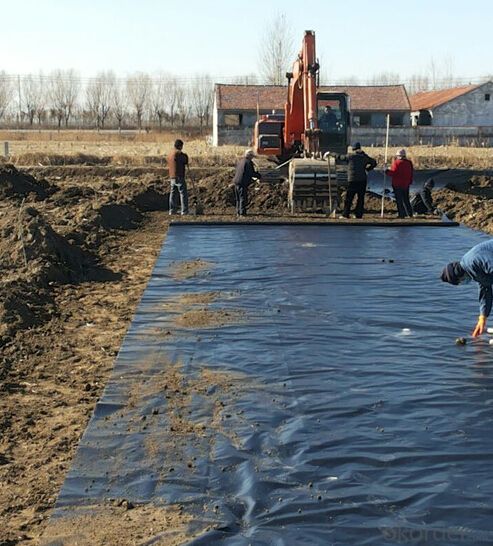


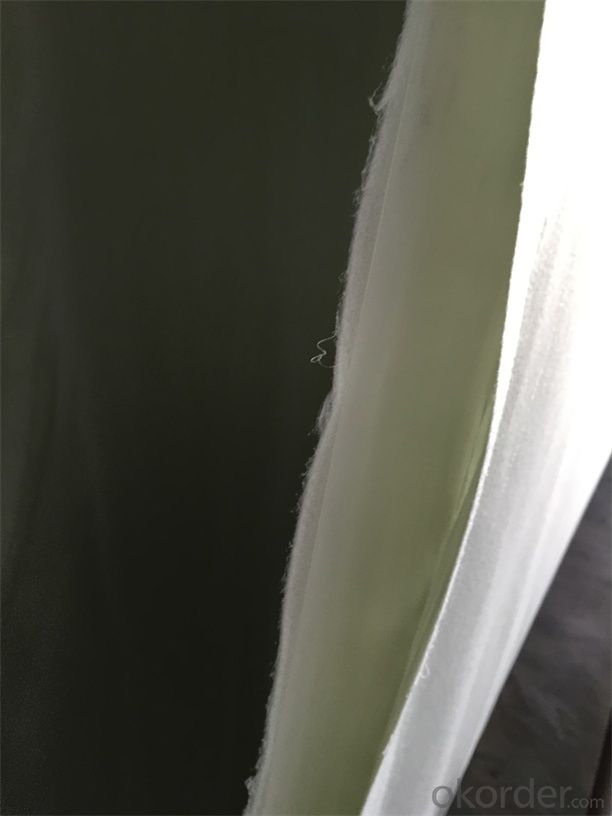
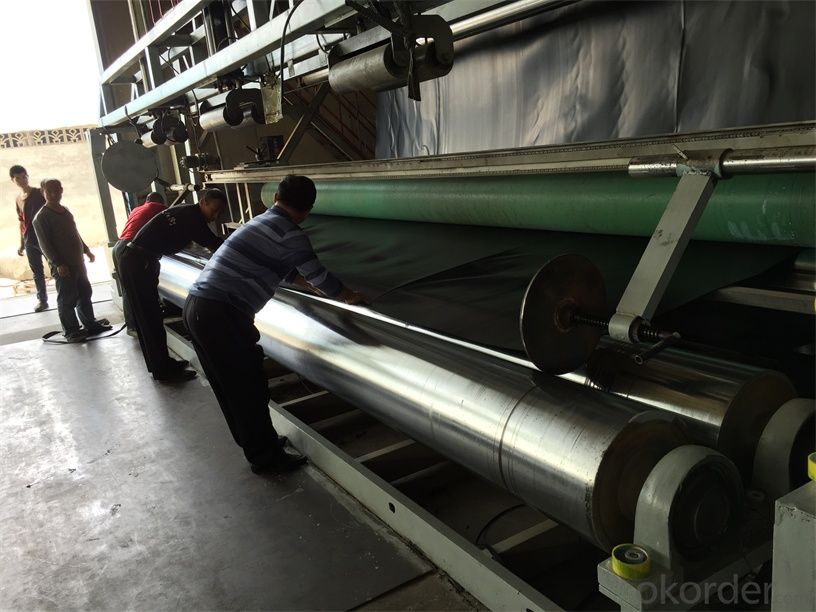
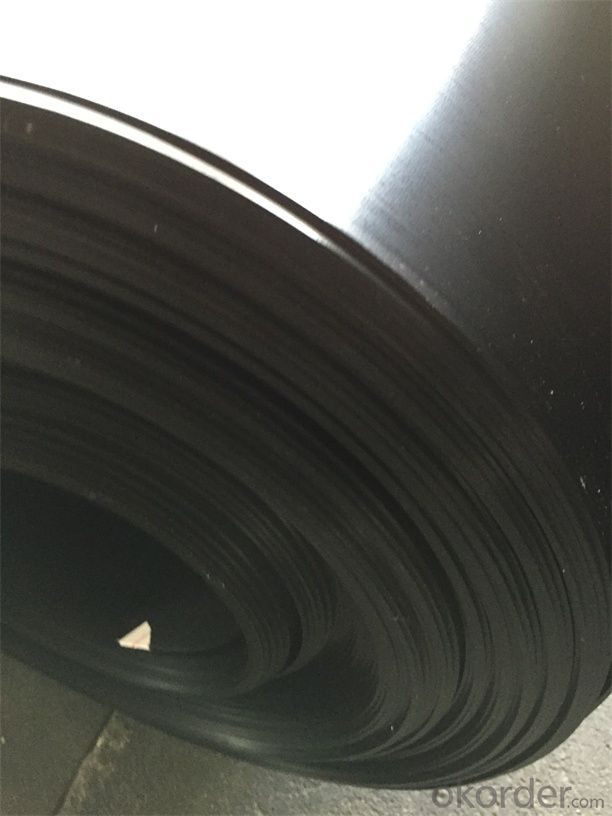

FAQ:
- Q1: Can you provide a sample for us?
A:Yes,We can send free samples,but customer need to pay the freight.
HDPE Geomembrane Price
- Q2: What is your minimum order quantity?
A:The minimum order quantity is 5000 ,but it is negotiable.
HDPE Geomembrane Price
- Q3:What is your payment terms?
A: T/T,Western Union,Paypal,L/C...
HDPE Geomembrane Price
- Q4:What is your delivery time?
A:Production time usually costs 2-20 days.
- Q:How are geomembranes used in construction projects?
- Geomembranes are used in construction projects as a barrier or liner to prevent the leakage or seepage of fluids, such as water or chemicals, in various applications such as landfills, reservoirs, and containment ponds. They provide a reliable and cost-effective solution to control and manage the flow of fluids, protecting the environment and ensuring the integrity of the construction project.
- Q:What are the advantages of eletromembrane floor heating?
- 1, green and environmental protection, no environmental pollution electrothermal film heating system will not produce soot and dust, which is more in line with the requirements of urban planning, very suitable for the requirements of going green and environmental protection in modern society. 2, warm like the natural sunlight due to the electrothermal?film heating system use radiation mode to supply heating, it can bring people warm and comfortable feeling like bathing in the sunlight. Which will not produce dry and hot feeling like that produced by traditional heating system. 3, low temperature operation, safe and reliable The electrothermal film surface will keep running in low temperature during work and the highest temperature will not exceed 60 degrees Celsius, so scald, explosion and fire will not happen. The whole system is connected through parallel mode, running very stable and with high feasibility. 4, can be charged according to households As electrothermal?film heating system can sdapy to the needs of a variety of users, so it can be measured according to households, units or floors, etc., which enable users to control the electricity consumption freely.
- Q:How are geomembranes manufactured?
- Geomembranes are manufactured through a process called extrusion, which involves melting and shaping high-density polyethylene (HDPE) into thin sheets. These sheets are then cooled, rolled, and cut into the desired dimensions. Additional layers or coatings may be added to enhance the geomembrane's strength, flexibility, or resistance to chemicals.
- Q:How do geomembranes prevent seepage?
- Geomembranes prevent seepage by acting as a barrier or liner that effectively isolates liquids, gases, or contaminants from infiltrating or escaping through the underlying soil or structure. They are typically impermeable or have very low permeability, which means they do not allow the passage of fluids or substances through them. This prevents seepage by creating a reliable barrier that can withstand pressure and maintain the integrity of the containment system.
- Q:What are the installation requirements for geomembranes in landfill caps?
- The installation requirements for geomembranes in landfill caps typically include proper surface preparation, including removal of debris and smoothing of the subgrade. Additionally, the geomembrane should be placed on a geotextile cushion to protect it from punctures. Seams must be properly welded or bonded to ensure a watertight seal. Finally, the geomembrane should be properly anchored and protected from damage during construction activities.
- Q:How are geomembranes tested for permeability?
- Geomembranes are tested for permeability using a variety of methods. One common method is to conduct a hydraulic conductivity test, where water is applied to the geomembrane under controlled conditions and the rate at which water passes through it is measured. Other tests include the use of pressure heads or gradients to determine the flow of liquids through the geomembrane. Additionally, laboratory tests such as the ASTM standard test methods are employed to assess permeability characteristics. Overall, these testing methods help determine the permeability properties of geomembranes and ensure their suitability for specific applications.
- Q:Can composite geo-membrane be used for roof leaks?
- No, usually we use SBS for roof waterproof. Composite geo-membrane is often used on the road and bridge projects.
- Q:How do geomembranes perform in high temperature environments?
- Geomembranes perform well in high temperature environments due to their excellent heat resistance properties. They are specifically designed to withstand elevated temperatures without any significant deterioration in their performance. The material used in geomembranes, such as HDPE (high-density polyethylene), has a high melting point and can withstand temperatures up to 120°C (248°F) or even higher. This allows them to be used in various applications, including mining, oil and gas, and waste management, where high temperatures may be encountered. Moreover, geomembranes also provide excellent resistance to UV radiation, chemical exposure, and mechanical stress, further enhancing their performance in high temperature environments.
- Q:Which brand of screen protector is better for note3?
- Many tempered films with considerable sales are cheap and of poor quality. Nowadays many manufacturers produce these faked tempered films to deceive consumers for the sake of commercial benefit.
- Q:What are the factors to consider when selecting a geomembrane for a specific application?
- When selecting a geomembrane for a specific application, several factors need to be considered. These include the type of project, the environmental conditions, the required performance specifications, the installation method, and the budget. Additionally, factors such as the physical properties of the geomembrane, its compatibility with other materials, and its durability and longevity are crucial. It is also important to consider any regulatory requirements and the availability of the product in the desired size and quantity.
1. Manufacturer Overview |
|
|---|---|
| Location | |
| Year Established | |
| Annual Output Value | |
| Main Markets | |
| Company Certifications | |
2. Manufacturer Certificates |
|
|---|---|
| a) Certification Name | |
| Range | |
| Reference | |
| Validity Period | |
3. Manufacturer Capability |
|
|---|---|
| a)Trade Capacity | |
| Nearest Port | |
| Export Percentage | |
| No.of Employees in Trade Department | |
| Language Spoken: | |
| b)Factory Information | |
| Factory Size: | |
| No. of Production Lines | |
| Contract Manufacturing | |
| Product Price Range | |
Send your message to us
Waterproof Lliner HDPE Geomembrane for Pond and Lake Dam
- Loading Port:
- Qingdao
- Payment Terms:
- TT OR LC
- Min Order Qty:
- 5000 m²
- Supply Capability:
- 2000000 m²/month
OKorder Service Pledge
OKorder Financial Service
Similar products
New products
Hot products
Hot Searches
Related keywords
